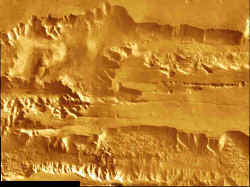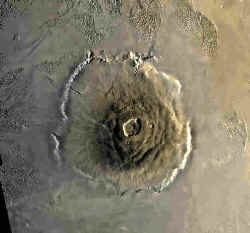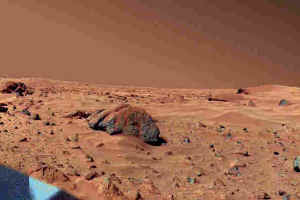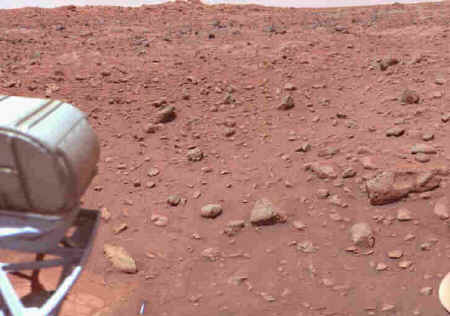|

Canyons and valleys - evidence of erosion by landslides
and (?) water
|
Mars, more than any other planet, has characteristics
that would seem to make it an Earth-like world. Its period of rotation and
the inclination of its axis are similar to those of the Earth. Mars is
similar in composition to the Earth, but probably has less iron and more
lightweight elements. Finally, only Earth and Mars, among the inner planets,
have satellites. However, the surfaces of Earth and Mars are very different.
The Earth’s surface is continuously modified. Plate tectonics changes the
locations of such features as continents, ocean basins, mountain ranges, and
volcanoes. The abundance of water on the Earth’s surface enhances the
weathering and erosion of material on the surface. High areas are destroyed
and low areas are filled in. Finally, the activity of life enhances
weathering and erosion of the surface, and has drastically altered the
composition of the Earth’s atmosphere and oceans.
|

Olympus Mons Volcano -
25 Kilometers high!
|
In contrast to the Earth, the surface of Mars is very
old, and changes very slowly. Mars is slightly more than one quarter of the
volume of Earth. This means that the interior of the planet has largely
cooled off. Mars thus lacks major tectonic activity, although Marsquakes
have been detected. The abundance of large volcanoes and wide rift valleys
on its surface testify to past events, but these features are all more than
several hundred million years. Mars also lacks surface water. Again, there
is evidence that water may have flowed on Mars early in its history
(billions of years ago) but now the surface of the planet is very dry. None
of the Earth’s usual water related surface processes including streams,
glaciers, and ocean, are active on Mars. However, spacecraft have
photographed abundant sand dunes on the Martian surface, as well as dust
storms in the atmosphere. These indicate that wind processes are still
active on Mars, just like on Earth. There is currently no evidence for life
on Mars.
|

A view of the Martian surface from the viking 1 lander. Note
sand dunes.
|
The surface of Mars is marked by abundant impact craters.
These formed when asteroids struck the planet. The Earth is also hit by
extraterrestrial objects, but here craters are quickly destroyed by erosion
and surface processes. This difference is another indication that the
surface of Mars is old.
However, there is a feature on Mars that is somewhat
similar to Earth, especially the canals that look like great rivers. Some
scientists feel that these are evidence that water was once present on the
surface. These channels have a curious history. After they were observed by
Pietro Secchi in 1876, Giovanni Schiaparelli made a map of them in 1877. The
map used the Italian word canali which means channel. English speaking
countries thought they meant canal, which is a human-made structure and
stories began of Martians. These stories were widespread up to the middle
20th century. In our language, the term Martians is commonly used to
describe inhabitants from other planets. These channels are probably of
water origin, and were present when the atmosphere supported water.

Another viking lander view of the surface of Mars
PROCEDURE: